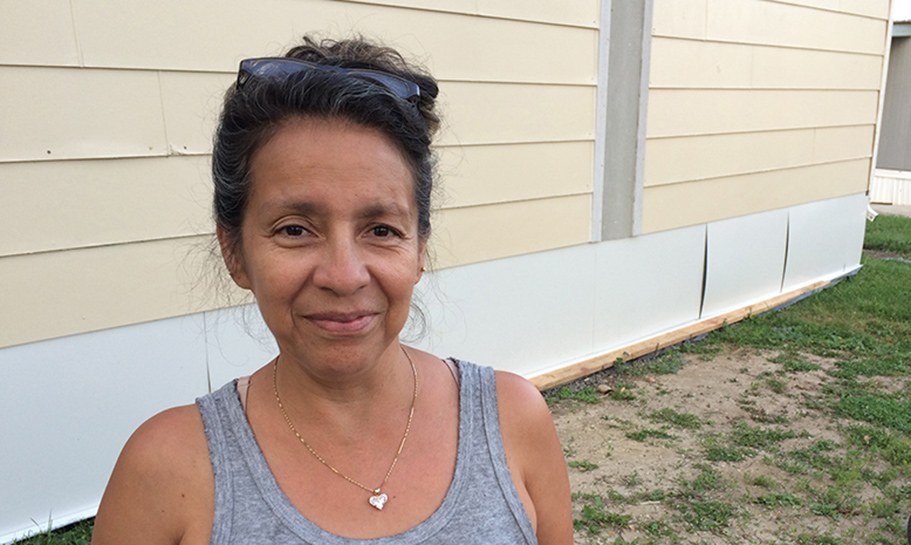A Durable Community in a Mobile Home Park

Irma Bautista has lived in Lago Vista Mobile Home Park with her family since 2007. She wants to make language instruction more available to help bridge ethnic groups. Photo by Kristin Jones
By Kristin Jones
In Lago Vista Mobile Home Park, at the northeastern edge of the city of Loveland, the homes aren’t very mobile; despite the name, they’re expensive to move. That’s why strengthening the community, and fostering pride in the place, is as important as it is anywhere.
Demand for mobile homes nationwide has never been stronger, due in part to an anemic supply of low-income housing in some places in the country, The Wall Street Journal reported in April.
Loveland, a Front Range bedroom community south of Fort Collins, is one of those places. Home values there have shot up 31 percent since January 2012, while rental costs have gone up nearly as much, according to the real estate website Zillow.
The median home sale price in Loveland of $244,000 is well out of reach for most low-income families. Used mobile homes in Loveland can go for a fraction of that cost.
Lago Vista Mobile Home Park was established in 1991 near Horseshoe Lake, before the city of Loveland sprawled out around it. It is unincorporated, an island cut off from city services like sewers and street repair. Amid a spate of public buyouts of mobile-home park operators, Lago Vista remains privately owned by a California-based investor.
And it’s growing. Clayton Homes—the nation’s biggest seller of mobile homes—recently sold 29 new units in Lago Vista, said manager Janeen Sepulveda. She estimates the population of the park at more than 1,000 residents, in 299 lots.
Sepulveda says when she moved into the park in 1999, she never felt proud of where she lived.
“I never invited people to my house,” she says. “Ever.” She didn’t want her friends to see drug deals, domestic violence, arrests.
That has changed, Sepulveda says.
“For the first time in 15 years, I’m not ashamed to tell people, ‘I’m the manager, and I live right there,’” says Sepulveda, as she sits beside the swimming pool at the park’s clubhouse, where she works.
For Sepulveda, building pride of place begins with simple things like maintaining lawns and keeping homes freshly painted. Her approach to managing the park is a mix of carrot and stick. She has pushed rules that require residents to maintain certain standards in their homes, but also reaches out to let people know, for instance, where to get discarded paint at the landfill.
Residents complain of racism and intimidation by staff members who are no longer employed by the park. Sepulveda is working to reverse that perception by opening the park to more Hispanic families. She also says she works with people who are late on payments; most residents own their homes—many of them through adjustable-rate mortgages—but owe the park around $485 a month to rent the land and pay for trash collection and sewage disposal.
“I don’t want anybody feeling intimidated,” Sepulveda says.
Laney Howard’s approach to building community here is more spiritual, and focuses on education. She and her husband Duncan worked at a mission school in Guatemala in the 1990s, during the last years of the country’s civil war. The couple, active in Loveland’s Faith Evangelical Presbyterian Church, moved to Lago Vista in 2012 after retiring from their jobs as school teachers.
With help from their church, they run a reading program for kids, a teen leadership program and a Bible study group, and they work with a local food bank to provide free lunches during the summer.
“People here want their kids to have a good education and be successful,” says Howard. “They want good things for their kids.”
On a recent Monday evening, The Colorado Trust gathered people living in Lago Vista to ask them what they thought the place needed to be healthy and thrive. Krista Martinez has been working there as The Trust’s community partner as part of a new grantmaking strategy that asks residents to come up with their own plans to build healthy communities.
The neighbors first split into two groups, by language. When they reconvened, they found that they wanted the same things: Support from their neighbors, communication across ethnic groups, and a neighborhood that is safe for kids to play in, free of drug abuse.
How do you get there? There were plenty of ideas, and they all seemed to bubble up twice—once in each language: block parties, cooking classes, a bulletin board advertising the community’s activities.
Irma Bautista has lived in the park with her two children since 2007.
When she first moved here, she cried for two months; the neighbors seemed so private, so cut-off.
“Now I’m trying to be involved in everything,” she says. During the meeting, she traversed between English and her native Spanish, and was the only person who seemed to be friends with everyone else in the room.
She was especially enthusiastic when somebody raised the idea of a walking group that doubles as language exchange: “I like that!” she exclaimed.
Later, the group talked about next steps: More meetings, these ones about the park’s infrastructure and about keeping its young people safe, educated and happy. And a planning committee for community events in the summer: a movie night in late July, and a bigger neighborhood party in August.

